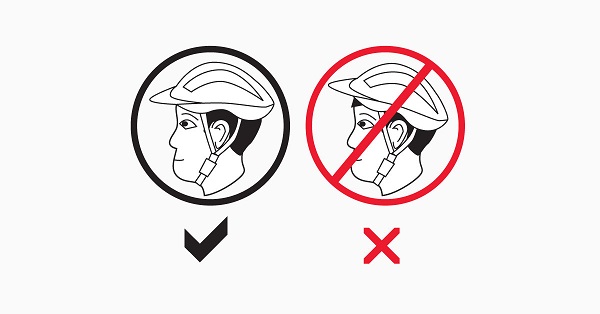Bicycle helmets are an important piece of gear for any cyclist. They protect you from head injuries and provide a layer of protection to your brain. However, choosing the right one can be a challenge. There are many different types of bicycle helmets and you need to make sure you get the right one for your needs and the type of riding you do. This article is going to help you understand the different types of bicycle helmets and which one you should choose. Discover the mountain bike with disc brakes.
How to measure bicycle helmet size?

Step 1: Measure your head: Measure your head from top to bottom. Measure the circumference at the widest point of your head.
Step 2: Measure your helmet: Measure the inside diameter of your helmet from the top of your head to the bottom.
Step 3: Compare your helmet size to the manufacturer’s size chart: Look on the back of the helmet or on the helmet’s website to find the size chart.
Step 4: Find the right size for you: Find your helmet size by matching your head measurement with the manufacturer’s size chart. Keep reading https://federaleurope.org/how-to-build-a-mountain-bike-teeter-totter/
How to choose bicycle helmet?
Choosing a bicycle helmet is an important decision to make. It’s something that could save your life if you fall off your bike.
- Safety: The first thing you need to think about is safety. The more information you have on the product, the better. You should know if it’s safe and what type of material it’s made out of.
- Comfort: The next thing you need to consider is comfort. Make sure that it’s comfortable to wear and that it doesn’t hinder your movement. You should also consider how long you’ll be wearing it, as this will affect the way you choose it.
- Price: The last thing you need to consider is price. If you’re looking for a cheap helmet, you might not be able to find one that’s both safe and comfortable. You should also make sure that it’s safe for you and your children.
- Size: Another thing you need to consider is size. Make sure that the helmet fits you properly. You’ll want to make sure that it fits your head comfortably and that it’s not too big or small.
- Material: The next thing you need to think about is material. You should know what type of material the helmet is made out of. If it’s plastic, you’ll want to know what type of plastic it is.
- Design: The next thing you need to think about is design. You should know what type of design the helmet has and what type of color it is. You should also consider the shape of the helmet, as this will affect the way you wear it.
- Color: The last thing you need to consider is color. You should know what type of color the helmet is and what type of pattern it has.
- Brand: The last thing you need to consider is brand. You should know what type of brand the helmet is and what type of logo it has.
- Warranty: The last thing you need to think about is the warranty. You should know what type of warranty the helmet has and how long it lasts.
- Features: The last thing you need to think about is its features. You should know what type of features the helmet has and if it’s waterproof or not.
The Importance of Wearing a Bicycle Helmet
- A bicycle helmet is an essential item. They’re not only great for protecting your head, but they can also save your life.
- A bicycle helmet protects you from the dangers of cycling. It can save your life if you fall off your bike or are involved in an accident.
- If you’re going to be riding a bicycle, it’s important to wear a helmet. Not only is it good for your safety, but it’s also good for your health.
- Wearing a bicycle helmet will keep you safe and protect you from the dangers of cycling.
- Wearing a bicycle helmet is important for your safety. It’s not only good for your safety, but it’s also good for your health.
When to change the bicycle helmet?
It is very common to buy a helmet and leave it there for years and years. That is wrong, and although it sounds like a myth, bicycle helmets expire. This is due to the fact that the material with which they are manufactured loses properties, hardens and protects worse from blows over time. On average, it is usually recommended to change the helmet every 5 or 6 years, even if they have not suffered any type of blow.
Of course, this figure is not absolute and can vary greatly. It is not the same to store the helmet in a place that is exposed to the sun every day, withstanding many changes in temperature, as in a place in the shade, but even so, change it every five or six years if you ride a bike frequently and if not, also. If you don’t go out much, you can bet on cheaper models so that it doesn’t hurt so much to pay for a new helmet.
If we have a hard fall, it is likely that the helmet has suffered structural damage (visible or not visible, be careful with this), so it has already fulfilled the purpose for which it was manufactured. If your helmet is cracked or has split, change it because it will no longer protect you.
The mission of a helmet is to protect our head from blows and if we bet on a manufacturer that meets the necessary safety standards, we will obtain similar protection in a cheap helmet and in an expensive one. So what is the difference between one and the other?
Although they protect the same, they are not as comfortable. An expensive helmet is lighter, it offers more air intakes to keep our heads cool, its visor is usually adjustable and the aerodynamics are improved. Aesthetic factors that have to be paid for or even extras such as hooks for GoPro cameras also come into play. All of this has to be paid for.
You yourselves can check the differences that I mentioned if you compare the blue helmet that you have two paragraphs above (economic model) compared to the IXS that heads this post and whose price is around 90 dollars. They have nothing to do with it.



